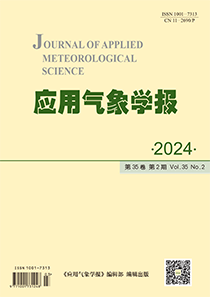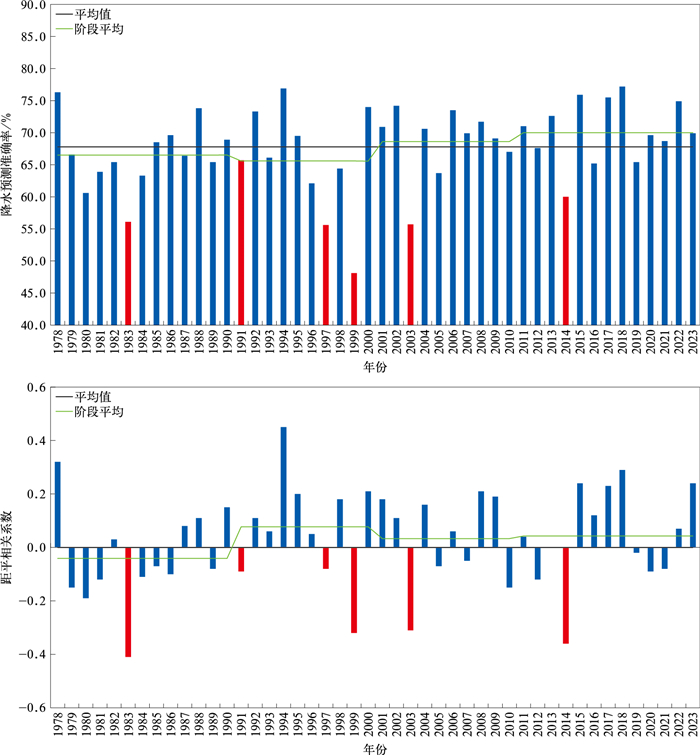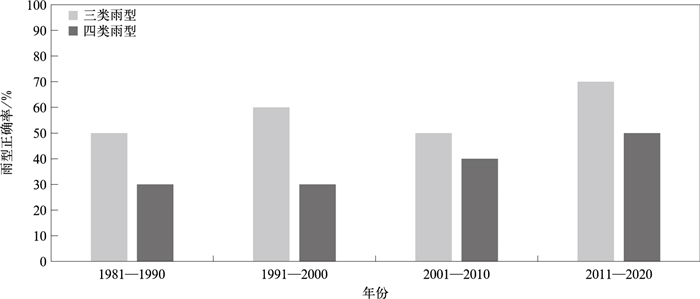|
[1]
|
Zhao Z G. Drought, Flood and Environmental Field in Summer in China. Beijing: China Meteorological Press, 1999.
|
|
[2]
|
Chen X F, Zhao Z G. Study and Application of Precipitation Forecast in Flood Season in China. Beijing: China Meteorological Press, 2000.
|
|
[3]
|
|
|
[4]
|
|
|
[5]
|
Wu T W, Song L C, Liu X W, et al. Progress in developing the Short-range Operational Climate Prediction System of China National Climate Center. J Appl Meteor Sci, 2013, 24(5): 533-543. doi: 10.3969/j.issn.1001-7313.2013.05.003 |
|
[6]
|
|
|
[7]
|
|
|
[8]
|
Wu T W, Yu R C, Lu Y X, et al. BCC-CSM2-HR: A high-resolution version of the Beijing Climate Center Climate System Model. Geosci Model Dev, 2021, 14(5): 2977-3006. doi: 10.5194/gmd-14-2977-2021 |
|
[9]
|
|
|
[10]
|
Chen L J, Li W J, Zhang P Q, et al. Application of a new downscaling model to monthly precipitation forecast. J Appl Meteor Sci, 2003, 14(6): 648-655. doi: 10.3969/j.issn.1001-7313.2003.06.002 |
|
[11]
|
Gu W Z, Chen L J, Zhang P Q, et al. Downscaling precipitation prediction in China based on optimization information extracted from monthly dynamic extended range forecast. Acta Meteor Sinica, 2009, 67(2): 280-287. doi: 10.3321/j.issn:0577-6619.2009.02.011 |
|
[12]
|
Gu W Z, Chen L J, Li W J, et al. Development of a downscaling method in China regional summer precipitation prediction. Acta Meteor Sinica, 2011, 25(3): 303-315. doi: 10.1007/s13351-011-0306-2 |
|
[13]
|
Ke Z J, Zhang P Q, Chen L J, et al. An experiment of a statistical downscaling forecast model for summer precipitation over China. Atmos Ocean Sci Lett, 2011, 4(5): 270-275. doi: 10.1080/16742834.2011.11446941 |
|
[14]
|
Jia X L, Chen L J, Luo J J. Climate prediction experiment for tropical cyclone genesis frequency using the large-scale circulation forecast by a coupled global circulation model. J Trop Meteor, 2014, 20(2): 103-111.
|
|
[15]
|
Liu C Z, Du L M, Ke Z J, et al. Multi-model downscaling ensemble prediction in National Climate Center. J Appl Meteor Sci, 2013, 24(6): 677-685. doi: 10.3969/j.issn.1001-7313.2013.06.004 |
|
[16]
|
Ren H L, Wu Y J, Bao Q, et al. The China multi-model ensemble prediction system and its application to flood-season prediction in 2018. J Meteor Res, 2019, 33(3): 540-552. doi: 10.1007/s13351-019-8154-6 |
|
[17]
|
|
|
[18]
|
Ren H L. Relationships between prediction errors and physical predictors in dynamical seasonal prediction. J Appl Meteor Sci, 2008, 19(3): 276-286. doi: 10.3969/j.issn.1001-7313.2008.03.003 |
|
[19]
|
|
|
[20]
|
Feng G L, Zhao J H, Zhi R, et al. Recent progress on the objective and quantifiable forecast of summer precipitation based on dynamical-statistical method. J Appl Meteor Sci, 2013, 24(6): 656-665. doi: 10.3969/j.issn.1001-7313.2013.06.002 |
|
[21]
|
Cheng Y B, Ren H L, Tan G R. Empirical orthogonal function-analogue correction of extra-seasonal dynamical prediction of East-Asian summer monsoon. J Appl Meteor Sci, 2016, 27(3): 285-292. doi: 10.11898/1001-7313.20160303 |
|
[22]
|
Liu Y, Fan K, Chen L J, et al. An operational statistical downscaling prediction model of the winter monthly temperature over China based on a multi-model ensemble. Atmos Res, 2021, 249. DOI: 10.1016/j.atmosres.2020.105262. |
|
[23]
|
Pang Y S, Zhang J, Qin N S, et al. Forecast model of interannual increment for summer runoff and its verification in the upper reaches of the Yangtze River. J Appl Meteor Sci, 2022, 33(1): 115-128. doi: 10.11898/1001-7313.20220110 |
|
[24]
|
Chen L J, Yuan Y, Yang M Z, et al. A review of physical mechanisms of the global SSTA impact on EASM. J Appl Meteor Sci, 2013, 24(5): 521-532. doi: 10.3969/j.issn.1001-7313.2013.05.002 |
|
[25]
|
|
|
[26]
|
Ren H C, Zuo J Q, Li W J. The impact of tropical Atlantic SST variability on the tropical atmosphere during boreal summer. J Climate, 2021, 34: 6705-6723.
|
|
[27]
|
Li W J. Study on the Mechanism and Prediction Methods of Drought and Flood Change in South China under Climate Warming. Beijing: China Meteorological Press, 2023.
|
|
[28]
|
Chen J Q, Shi X H. Possible effects of the difference in atmospheric heating between the Tibetan Plateau and the Bay of Bengal on spatiotemporal evolution of rainstorms. J Appl Meteor Sci, 2022, 33(2): 244-256. doi: 10.11898/1001-7313.20220210 |
|
[29]
|
Fu C B, Teng X L. Climate anomalies in China associated with E1 Niño/Southern Oscillation. Chinese J Atmos Sci, 1988, 12(Suppl Ⅰ): 133-141.
|
|
[30]
|
|
|
[31]
|
|
|
[32]
|
|
|
[33]
|
McPhaden M J. Playing hide and seek with El Niño. Nature Clim Change, 2015, 5(9): 791-795. doi: 10.1038/nclimate2775 |
|
[34]
|
|
|
[35]
|
|
|
[36]
|
Song X M, Zhang R H, Rong X Y. Influence of intraseasonal oscillation on the asymmetric decays of El Niño and La Niña. Adv Atmos Sci, 2019, 36(8): 779-792. doi: 10.1007/s00376-019-9029-6 |
|
[37]
|
Zhou X Y, Liu F, Wang B, et al. Different responses of East Asian summer rainfall to El Niño decays. Climate Dyn, 2019, 53(3): 1497-1515.
|
|
[38]
|
Ashok K, Behera S K, Rao S A, et al. El Niño Modoki and its possible teleconnection. J Geophys Res Oceans, 2007, 112. DOI: 10.1029/2006JC003798. |
|
[39]
|
Feng J, Chen W, Tam C Y, et al. Different impacts of El Niño and El Niño Modoki on China rainfall in the decaying phases. Int J Climatol, 2011, 31(14): 2091-2101. doi: 10.1002/joc.2217 |
|
[40]
|
Yuan Y, Yang S. Impacts of different types of El Niño on the East Asian climate: Focus on ENSO cycles. J Climate, 2012, 25(21): 7702-7722. doi: 10.1175/JCLI-D-11-00576.1 |
|
[41]
|
Xue F, Liu C Z. Influence of moderate intensity ENSO on summer precipitation in eastern China and its comparative analysis with strong ENSO. Chinese Sci Bull, 2007, 52(23): 2798-2805. doi: 10.3321/j.issn:0023-074x.2007.23.017 |
|
[42]
|
|
|
[43]
|
|
|
[44]
|
Ren H L, Lu B, Wan J H, et al. Identification standard for ENSO events and its application to climate monitoring and prediction in China. J Meteor Res, 2018, 32(6): 923-936. doi: 10.1007/s13351-018-8078-6 |
|
[45]
|
|
|
[46]
|
|
|
[47]
|
|
|
[48]
|
Institute of Atmospheric Physics, Chinese Academy of Sciences. Air-sea Interaction and Long-term Forecast of Drought and Flood. Beijing: Science Press, 1978.
|
|
[49]
|
|
|
[50]
|
Gill A E. Some simple solutions for heat-induced tropical circulation. Q J R Meteor Soc, 1980, 106(449): 447-462.
|
|
[51]
|
|
|
[52]
|
|
|
[53]
|
|
|
[54]
|
Ding Y H. Study on the Persistent Torrential Rain in Jianghuai Basin in 1991. Beijing: China Meteorological Press, 1993.
|
|
[55]
|
|
|
[56]
|
Huang R H, Yin B Y, Liu A D. Intraseasonal Variability of the East Asian Summer Monsoon and Its Association with the Convective Activities in the Tropical Western Pacific//Climate Variability. Beijing: Chinese Meteorological Press, 1992.
|
|
[57]
|
|
|
[58]
|
Lu E, Ding Y H. Analysis of summer monsoon activity during the 1991 excessively torrential rain over Changjiang-Huaihe River Valley. J Appl Meteor Sci, 1997, 8(3): 316-324. http://qikan.camscma.cn/article/id/19970345 |
|
[59]
|
Mao J Y, Wu G X. Intraseasonal variability in the Yangtze-Huaihe River rainfall and subtropical high during the 1991 Meiyu period. Acta Meteor Sinica, 2005, 63(5): 762-770. doi: 10.3321/j.issn:0577-6619.2005.05.020 |
|
[60]
|
|
|
[61]
|
Ni D H, Sun Z B, Zhao Y C. Influence of ENSO cycle at different phases in summer on the East Asian summer monsoon. J Nanjing Inst Meteor, 2000, 23(1): 48-54. doi: 10.3969/j.issn.1674-7097.2000.01.008 |
|
[62]
|
Zhang R H, Sumi A, Kimoto M. Impact of El Niño on the East Asian monsoon. J Meteor Soc Japan, 1996, 74(1): 49-62. doi: 10.2151/jmsj1965.74.1_49 |
|
[63]
|
|
|
[64]
|
Sun Y, Ding Y H. A study on physical mechanisms of anomalous activities of East Asian summer monsoon during 1999. Acta Meteor Sinica, 2003, 61(4): 406-420. doi: 10.3321/j.issn:0577-6619.2003.04.003 |
|
[65]
|
|
|
[66]
|
|
|
[67]
|
Kao H Y, Yu J Y. Contrasting eastern-Pacific and central-Pacific types of ENSO. J Climate, 2009, 22(3): 615-632. doi: 10.1175/2008JCLI2309.1 |
|
[68]
|
Kug J S, Jin F F, An S I. Two types of El Niño events: Cold tongue El Niño and warm pool El Niño. J Climate, 2009, 22(6): 1499-1515. doi: 10.1175/2008JCLI2624.1 |
|
[69]
|
|
|
[70]
|
Weng H Y, Ashok K, Behera S K, et al. Impacts of recent El Niño Modoki on dry/wet conditions in the Pacific rim during boreal summer. Climate Dyn, 2007, 29(2): 113-129.
|
|
[71]
|
Huang G, Yan Z W. Anomalous index of East Asian summer monsoon circulation and its interannual variation. Chinese Sci Bull, 1999, 44(4): 421-424. doi: 10.3321/j.issn:0023-074X.1999.04.020 |
|
[72]
|
|
|
[73]
|
Yuan Y, Yang S, Zhang Z Q. Different evolutions of the Philippine Sea anticyclone between the eastern and central Pacific El Niño: Possible effects of Indian Ocean SST. J Climate, 2012, 25(22): 7867-7883. doi: 10.1175/JCLI-D-12-00004.1 |
|
[74]
|
Xie S P, Kosaka Y, Du Y, et al. Indo-western Pacific Ocean capacitor and coherent climate anomalies in post-ENSO summer: A review. Adv Atmos Sci, 2016, 33(4): 411-432. doi: 10.1007/s00376-015-5192-6 |
|
[75]
|
Li W J, Zhang R N, Sun C H, et al. Recent research advances on the interannual-interdecadal variations of drought/flood in south China and associated causes. J Appl Meteor Sci, 2016, 27(5): 577-591. doi: 10.11898/1001-7313.20160507 |
|
[76]
|
|
|
[77]
|
|
|
[78]
|
Chen L J, Gu W, Li W J. Why is the East Asian summer monsoon extremely strong in 2018?-Collaborative effects of SST and snow cover anomalies. J Meteor Res, 2019, 33(4): 593-608. doi: 10.1007/s13351-019-8200-4 |
|
[79]
|
|
|
[80]
|
|
|
[81]
|
Okumura Y M, DiNezio P, Deser C. Evolving impacts of multiyear La Niña events on atmospheric circulation and US drought. Geophys Res Lett, 2017, 44(22): 11614-11623.
|
|
[82]
|
Wang H J. The weakening of the Asian monsoon circulation after the end of 1970's. Adv Atmos Sci, 2001, 18(3): 376-386. doi: 10.1007/BF02919316 |
|
[83]
|
Gao H, Wang Y G, He J H. Weakening significance of ENSO as a predictor of summer precipitation in China. Geophys Res Lett, 2006, 33. DOI: 10.1029/2005GL025511. |
|
[84]
|
Ding Y H, Sun Y, Wang Z Y, et al. Inter-decadal variation of the summer precipitation in China and its association with decreasing Asian summer monsoon. Part Ⅱ: Possible causes. Int J Climatol, 2009, 29(13): 1926-1944. doi: 10.1002/joc.1759 |
|
[85]
|
Sun L Y, Yang X Q, Tao L F, et al. Changing impact of ENSO events on the following summer rainfall in Eastern China since the 1950s. J Climate, 2021, 34(20): 8105-8123. doi: 10.1175/JCLI-D-21-0018.1 |
|
[86]
|
Yuan Y, Gao H, Li W J, et al. The 2016 summer floods in China and associated physical mechanisms: A comparison with 1998. J Meteor Res, 2017, 31(2): 261-277. doi: 10.1007/s13351-017-6192-5 |
|
[87]
|
Ding Y H, Liu Y Y, Hu Z Z. The record-breaking Mei-yu in 2020 and associated atmospheric circulation and tropical SST anomalies. Adv Atmos Sci, 2021, 38(12): 1980-1993. doi: 10.1007/s00376-021-0361-2 |
|
[88]
|
Zhao J H, Zuo J Q, Zhang H, et al. Extreme precipitation driven by the rapid tropical Atlantic warming and the second developing La Niña over the Yangtze-Huaihe River Basin in August 2021. Climate Dyn, 2023, 61(5): 2581-2598.
|
|
[89]
|
Chen L J, Zhao J H, Gu W, et al. Advances of research and application on major rainy seasons in China. J Appl Meteor Sci, 2019, 30(4): 385-400. doi: 10.11898/1001-7313.20190401 |
|
[90]
|
Li W J. Modern Climate Business. Beijing: China Meteorological Press, 2012.
|
|
[91]
|
Johnson S J, Stockdale T N, Ferranti L, et al. SEAS5: The new ECMWF seasonal forecast system. Geosci Model Dev, 2019, 12(3): 1087-1117. doi: 10.5194/gmd-12-1087-2019 |
|
[92]
|
Liu Y Y, Hu Z Z, Wu R G, et al. Subseasonal prediction and predictability of summer rainfall over Eastern China in BCC_AGCM2.2. Climate Dyn, 2021, 56(7): 2057-2069.
|
|
[93]
|
Mi Q C, Gao X N, Li Y, et al. Application of deep learning method to drought prediction. J Appl Meteor Sci, 2022, 33(1): 104-114. doi: 10.11898/1001-7313.20220109 |
|
[94]
|
Xie S, Sun X G, Zhang S P, et al. Precipitation forecast correction in South China based on SVD and machine learning. J Appl Meteor Sci, 2022, 33(3): 293-304. doi: 10.11898/1001-7313.20220304 |
|
[95]
|
Jin W X, Luo Y, Wu T W, et al. Deep learning for seasonal precipitation prediction over China. J Meteor Res, 2022, 36(2): 271-281. doi: 10.1007/s13351-022-1174-7 |
|
[96]
|
Li Y, Wang G F. Design and implementation of meteorological disaster risk management system. J Appl Meteor Sci, 2022, 33(5): 628-640. doi: 10.11898/1001-7313.20220510 |





 DownLoad:
DownLoad:

